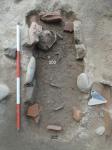Summary (English)
The seventh campaign on the Roman site of Tassignano di Capannori (Lu), TAX C/82 had two objectives: deepen the excavations south of room C (area D), and reopen the trench in room A, in order to check for the presence of more burials (T.1 was found in here in 2014).
The most interesting discovery in area D was an occupation layer (us 114-135) that presented a dense network of postholes and was bordered to the east by a structure (us 153-154), aligned NE-SW.
The layers obliterating this surface contained abundant pottery providing a significant sample of the material culture, which covers the period between the 1st and 4th centuries A.D., with a clear prevalence of 2nd-3rd century materials.The interpretation of the system of postholes in surface 114-135, their NW-SE alignment, and their density suggest that they formed the support for a raised timber structure. The proximity of the posts to room C suggests a timber extension south of the room, in relation to the reuse of the ancient balneum (the original function of room C) as a ‘house’, datable to mid-late antiquity. At present, the function of structure 153-154 remains unknown, although surface 135, and the edge of a depression sloping towards the south-east were identified. Further open-area excavation will be needed in order to follow its development and to see whether the depression is artificial or natural. It is unclear whether this structure is contemporary with the use of the palafitte structure or dates to an earlier phase. What seems certain is that it was contemporary with floor 135.
In room A, a small sub-circular pit was emptied (us 202). The fill contained pottery fragments, some of which reconstructable, including a kitchen-ware jar and a coarse-ware table amphoretta datable to the 1st century A.D., thus providing a precise chronological reference for the formation of the deposit. The fill also contained a number of iron studs of unknown function.
Lastly, the excavation of us 7 – the fill of a small rectangular pit (us 205) aligned east-west, bordered by stones and tile fragments (us 204) – has confirmed the hypothesis that it was a child burial (T. 2), associated with the adult grave (T. 1) found in 2014. Unfortunately, the skeleton’s extremely poor state of preservation confirmed the systematic robbing that took place after the area was used as a burial place.
Despite the absence of dating material, some fragments of opus signinum, which clearly came from the robbing of the late Republican balneum, inserted among the cobbles and tile fragments of us 204 surrounding the grave, confirm the burial’s dating to the late antique/early Medieval period.
- Alessandro Giannoni
Director
- Alessandro Giannoni
Team
- Elena Genovesi, Fabrizio Burchianti, Ilaria Rinaldi
- Alessandro Giannoni
Research Body
- Gruppo Archeologico Capannorese
Funding Body
- Comune di Capannori; Fondazione Banca del Monte di Lucca






![Download [PDF]](/excavation/skins/fasti/images/results/download_sml.png)
